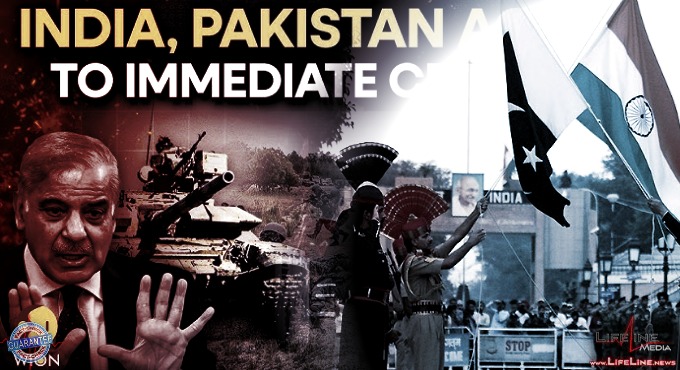U.S.-Led Talks Calm Nuclear Threats Amid Lingering Doubts

FACT-CHECK GUARANTEE
Political Tilt
& Emotional Tone
The article presents a centrist to center-right perspective, emphasizing U.S. diplomatic efforts and strategic interests without strong partisan language or bias towards either India or Pakistan.
Generated using artificial intelligence.
The tone is cautiously somber and serious, reflecting the gravity and fragility of the ceasefire and ongoing tensions without overt optimism or anger.
Generated using artificial intelligence.
Updated:
Read
After weeks of mounting tension, India and Pakistan — nuclear-armed rivals with a long, bitter history — have agreed to a ceasefire. The move, reached after intense U.S.-led negotiations, has eased the immediate threat of war. Yet as the dust settles, deep uncertainties remain.
U.S. Steps In, Tensions Ease — At Least for Now
President Trump announced the deal, congratulating both nations for what he called “common sense and great intelligence.” Behind the scenes, U.S. diplomats worked tirelessly.
Secretary of State Marco Rubio and Vice President J.D. Vance reportedly pressed Indian Prime Minister Modi and Pakistan’s Prime Minister Sharif to find common ground.
After days of shuttle diplomacy and tense exchanges, the ceasefire was set to begin at 5 p.m. Indian Standard Time. The world exhaled — at least for now.
Here’s what we know:
Missiles, Air Strikes — and a Region on Edge
The road to this uneasy truce was marked by violence. Just days ago, Kashmir saw one of its bloodiest episodes in years: missile barrages, air raids lighting up the night, and artillery shells raining down along the Line of Control.
The crisis erupted after a terrorist attack on tourists in Kashmir — a tragedy India quickly blamed on Pakistan. Retaliation followed. Indian forces struck targets deep inside Pakistan’s territory; Pakistani artillery answered in kind.
Civilians bore the brunt. More than 70 people died, most of them Kashmiri residents caught in the crossfire. Thousands fled as border villages became war zones.
Fragile Peace and Ongoing Uncertainties
A Fragile Peace — and Familiar Doubts
History offers little comfort. Ceasefires between India and Pakistan have come and gone, often unraveling within days or weeks. Accusations are already surfacing: hours after this new agreement took effect, reports emerged of renewed firing across the border.
Each side blames the other for breaking faith. The pattern is depressingly familiar: hope rises with every handshake, only to be dashed by gunfire soon after.
Nuclear Stakes — and Unanswered Questions
Why does this matter so much? The answer is stark: both countries possess nuclear weapons and a history of bitter conflict. Any miscalculation could spiral into catastrophe — not just for South Asia, but for the world.
Prime Minister Sharif thanked President Trump for his role in brokering peace. Indian officials, meanwhile, stressed that real progress depends on direct dialogue between Delhi and Islamabad — a reminder that old grievances do not vanish overnight.
America’s Interests — and What Comes Next
For Washington, stability in South Asia is not a distant concern; it is a strategic priority. Instability here can ripple outward — fueling terrorism, rattling energy markets, and threatening global supply chains.
This ceasefire is a testament to American diplomatic influence but also an urgent reminder: peace in this region is always provisional. For now, guns have fallen silent along the Line of Control.
But everyone knows how quickly that can change. The world will be watching to see whether this fragile truce holds or collapses amid fresh accusations and old animosities.
One thing is certain: in South Asia’s high-stakes game of peace and war, nothing is ever settled for long.

Join the discussion!
Be the FIRST to comment on ‘FRAGILE Ceasefire: Will INDIA and PAKISTANs Dangerous Peace Survive?’